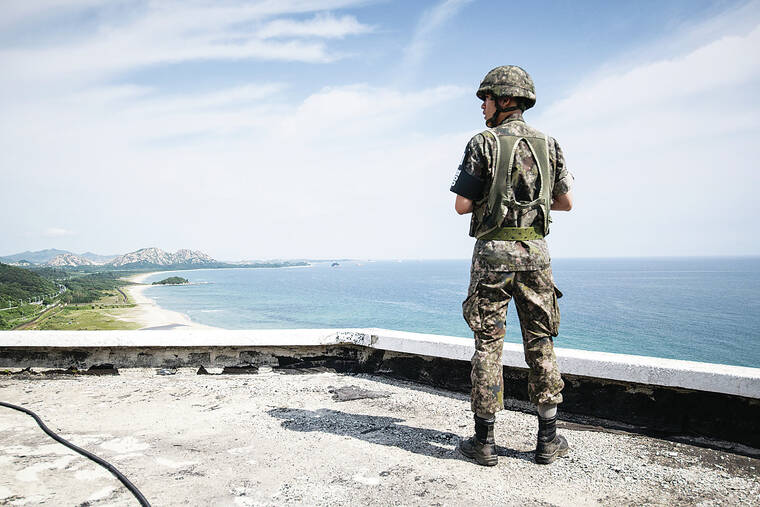Korea’s army of senior citizens ready for battle. ‘I don’t remember the rifles being so heavy’
Dressed in borrowed camouflage fatigues, they fumbled with their ammunition belts and K2 assault rifles. Some had white hair and a slow, shuffling gait; their average age was 63, the oldest 75.
It was the most unconventional batch of trainees that the 52nd Infantry Division’s Seocho Reserve Forces Training Center had ever seen, and Lt. Col. Hwang Hyeon-seok received them with a strained smile, desperately hoping that none of them would get hurt.
ADVERTISING
“I couldn’t sleep at all last night,” Hwang told one of them with a nervous laugh. “Your enthusiasm worries me.”
His concern was met with good-natured chuckles, but no reassurances.
Excluding the two women in the group, most of these retirees or near-retirees had undergone South Korea’s compulsory military service in their youth. But the decades of rust were showing.
“I don’t remember the rifles being so heavy,” said 62-year-old Kang Shin-kwang.
As a young conscript four decades ago, Kang was a machine gunner stationed near the border with North Korea. But today, as the sticker pasted to his right breast indicates, he serves in the Senior Army.
Founded last summer by a group of civilians with no affiliation with the military, the Senior Army — which currently has around 500 members — is part senior citizens’ social club and part volunteer organization.
But it also has more profound ambitions as a solution to the effects of South Korea’s dismal fertility rate, which, as the lowest in the world, has spurred fears that the military will soon struggle to fill its ranks.
With the Senior Army assembled behind him in military formation, co-founder Choi Young-jin, a 62-year-old university politics professor, recited the group’s oath:
In light of the country’s population crisis, we will prepare ourselves so that we may one day be of service in the nation’s military reserves. A gimmick this was not. After taking out personal injury insurance policies for its members, the group had asked the military for the full package: two nights in the barracks and live-fire shooting drills.
“I’m not interested in training just for show,” said 63-year-old Kim Seok-beom, who recently retired from the railroad industry. “I want real-life applicability.”
But both of these requests had been denied, and the military had limited the number of participants to 20.
The 1953 armistice agreement between the U.S.- led United Nations Command and North Korea brought a cease-fire — but not an official end — to the Korean War.
In the 70-year-long standoff that followed, a delicate equilibrium has held.
North Korea, in addition to its nuclear weapons program, fields one of the world’s largest standing armies, with 1.3 million active duty soldiers and 7.6 million reservists.
South Korea has one of the most powerful conventional militaries in the world, exporting billions of dollars in tanks, missiles and fighter jets to countries all over — Poland, India, the United Arab Emirates.
But South Korea’s fertility crisis is now complicating its military prowess.
Under current law, all able-bodied South Korean men are required to serve in the military for a period of 18 to 21 months, depending on the branch.
But with South Korean women now giving birth to just 0.78 children over their lifetimes — far short of the 2.1 needed to maintain the current population — the military will soon find itself short on conscripts.
By 2040, according to the Korea Institute for Defense Analyses, a government think tank, the country’s active duty force will shrink from 500,000 to 360,000, its reserve force from 3.1 to 1.6 million.
The military hopes to offset these personnel shortages with technological advancements in robotics, autonomous vehicles and artificial intelligence-based combat systems, according to a defense ministry white paper published last year.
When reached for comment by The Times, the defense ministry declined to elaborate on these plans, but stated that recruiting the elderly was not among them.
It had only approved the Senior Army’s training exercises, a spokesperson said, “to promote diverse expressions of patriotism.”
As Team Yellow and Team Blue steeled themselves for battle, the instructors explained that the team that racked up the most kills in five minutes would win. In a small bunker at the end of the fake street, Choi rallied Team Yellow to talk strategy.
Neither the military’s flat-out dismissal nor the fretting of the instructors has discouraged the Senior Army.
Their pitch to the government is simple: even as the military seeks to reduce its reliance on human soldiers, there is no war effort that doesn’t need bodies. They can be the ones to supply them.
“Older South Koreans these days are very fit because they pass the time with hobbies like hiking,” Choi said. “In any case, the soldiers sent to the front in a war are essentially bullet sponges. As long as we are trained and ready, there is no reason we can’t do that just as well.”
Waistlines in the Senior Army, for the most part, were trim. And what they lacked in explosive athleticism they made up for with a weathered and time-tested hardiness.


